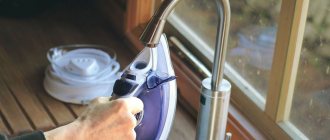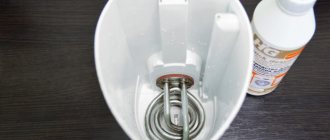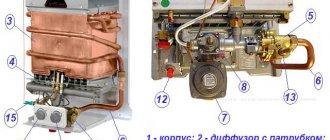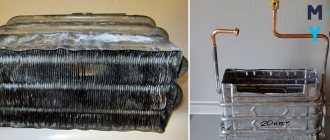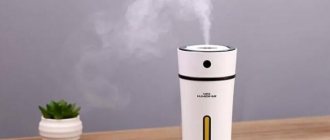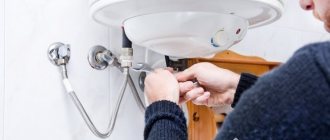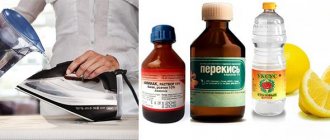A clothes steamer is a compact and convenient device that runs on water. Those who use it often have a question about how to clean the steamer from scale at home. This is due to the fact that during operation, scale forms in the device inside the tank and around the heating element, which affects the quality of smoothing the fabric and can cause damage to the device.
There are simple and inexpensive ways to remove limescale from a device. Later in the article we will tell you more about them.
Ironing a shirt using a steamer
Causes of scale
A clothes steamer is a household appliance that smoothes out wrinkles and creases in fabric using a stream of hot steam. The unit works in close interaction with water. Regardless of careful use, scale will form on its internal parts over time. Limescale is caused by the following reasons:
- hard tap water; ordinary tap water contains many foreign impurities, which quickly turn into solid deposits;
- intensive use of the device, the more often the steamer is turned on, the faster limescale deposits form.
Limescale poses a real danger to a household appliance. First of all, it worsens the heat transfer of heating elements. During operation, the steamer consumes more energy to warm up new portions of water, is subject to overload and fails prematurely. Plaque that forms in the inner tubes and at bends impedes the passage of liquid and makes the device less effective when used.
If the scale in the steamer is abundant and noticeable, it may leave whitish marks on clothes during operation.
Important! It is necessary to descale the steamer regularly, without waiting until the contaminants begin to really interfere with the operation of the device.
Clean cracks: radiators, seams, hood
There are many bottlenecks in cleaning: the seam between the sink and the countertop, baseboards, radiators, rubber on the refrigerator door, grout on the kitchen splashback. Furniture causes a lot of difficulties: dust gets clogged in the wooden grooves and behind the sofa cushions, and it is impossible to get it out with a cloth.
A narrow nozzle penetrates into the space between the batteries, and the steam washes away the dust so that many owners change their mind about updating the color of old radiators. The same thing happens with the hood: the non-removable parts remain dirty, even if the filter can be cleaned. The steam assistant penetrates into hard-to-reach places; you just need to wipe it with a cloth, because the steam destroys dirt, but does not absorb it.
Even a hand-held steam cleaner with a long nozzle with a power of 1200 W or more can handle this.
A steam cleaner cannot be used as a vacuum cleaner, but it replaces a mop and copes much better with tiles and tiles, especially if they are grooved. Vertical devices are designed for these purposes. The rotating brush picks up lint and small debris that the vacuum cleaner cannot handle.
Features of cleaning steamers of different types and models
Not all clothing steamers are suitable for cleaning at home. Before you begin removing plaque, you need to carefully inspect the household appliance and understand what type it is:
- Regular steamer. Such devices resemble an electric kettle in design and operating principle. Water is poured into the internal reservoir, it is evenly heated in full, and scale forms over time on all contact surfaces.
Conventional steamers are compact in size and low in price. - Steamer with pump. In such models, water flows to the heating element in small portions, and a special pump is responsible for supplying the liquid. Lime deposits settle mainly on its walls.
Steamers with a pump are more convenient to use, but require special care
You can descale the sender at home only if it is not equipped with a pump. Structures that include a pump must be sent to a service center for service. Cleaning on your own may result in damage to the unit.
Flaws
Price.
Most models are presented by German manufacturers. Therefore, the cost of a steam cleaner with a set of additional functions or attachments is high. Compliance with safety regulations. The work takes place with steam whose temperature exceeds 100 °C. If there are cracks in the supply tube or visible damage, do not turn on the electrical appliance and start working.
It is important to handle steam carefully while cleaning.
Not 100% effective. Even a powerful steam cleaner will not remove old, deeply ingrained dirt.
High humidity is dangerous for some surfaces
It is not recommended to use a steam generator to clean the seams of MDF cabinets. This leads to swelling in the area where the film is applied. Do not steam the joints of the window sill and the wall or window cracks with silicone. It lags behind and loses its insulating properties.
How and how to clean a steamer from scale using folk remedies
If slight scale appears in the steamer, it is not necessary to immediately resort to chemicals. To begin with, you can use home methods for removing deposits.
How to descale a steamer with citric acid
Citric acid perfectly corrodes hard lime deposits and helps restore cleanliness to the internal elements of the steamer. It is used according to a simple algorithm:
- pour a large spoonful of cleaning powder into a glass of warm water and stir;
- after the grains are completely dissolved, pour the product into the compartment of the household appliance;
- tilt the device over the sink and press the steam button.
Dirty water with limescale residues will drain from the steamer openings into the sink. It is necessary to press the button until the solution inside the unit has completely evaporated. After this, the entire procedure will need to be repeated using plain water. This will flush out any remaining cleaning product from the appliance reservoir.
Citric acid is recommended for cleaning metal steamers
Advice! To make citric acid more effective at removing contaminants, you can pour the solution into the compartment and leave the steamer to stand for 10-15 minutes.
How to clean a steamer with mineral water
Carbonated water works well against small scale deposits on the inner walls of the device. It contains carbon dioxide, which helps dissolve solid contaminants. The cleaning scheme looks like this:
- mineral water is poured into the steamer tank;
- heat the apparatus to maximum temperature;
- place over a basin or sink and release steam;
- Continue pressing the button until the soda completely evaporates from the reservoir.
As in the previous case, in conclusion, another cleaning cycle should be carried out to remove residual contaminants, but this time with plain water.
Mineral water is suitable for safe cleaning of plastic steamers
How to descale a steamer using vinegar
You can effectively descale your clothes steamer using table vinegar. It has a caustic composition and softens lime deposits when heated. You need to use it for cleaning according to the standard algorithm:
- 15 g of acidic product is stirred in 250 ml of warm liquid;
- pour water into the special compartment of the steamer;
- heat to maximum and release steam over the sink;
- Clean the unit with plain water again after all the vinegar solution has evaporated.
The only drawback of an acidic substance is its pungent odor. When cleaning, you will have to open the window; in addition, the unpleasant aroma may linger in the device itself for some time.
Concentrated vinegar essence for cleaning can only be used after dilution with water to 9%
How to clean limescale from a steamer with baking soda
Among household products, baking soda has a good effect on scale. The application of the powder looks like this:
- Stir 5 g of the product in a glass of water until completely dissolved;
- the resulting cleaning composition is poured into a fabric steamer;
- the device is left turned off for 4-5 hours;
- after the period has passed, the solution is drained;
- place clean water or mineral water with gas in the tank;
- heat the liquid and release it in the form of steam several times in a row.
The benefits of soda include its safety. The powder solution does not leave behind an unpleasant odor and does not cause any harm to either plastic or metal devices when cleaning.
Baking soda has a destructive effect on scale even without boiling
Preventive actions
You can protect your kitchen furniture from greasy and other contaminants if you regularly care for it, remove dust and stains using suitable tools and products.
It is advisable to observe the following rules:
- maintain moderate dryness and humidity in the room so that the furniture does not crack or become stained;
- try not to “burst” cabinet doors;
- Do not open alcohol or dye solutions on unprotected countertops;
- seal cracks in wood in a timely manner using beeswax;
- Remove fresh streaks and drops of paint or lime immediately using vegetable oil mixed with vinegar.
It is necessary to wipe the elements of the headset daily with a piece of flannel or velvet. Constant use of wet wipes may cause the material to become dull. Lacquered surfaces will not lose their shine if they are coated with wax, treated with a mixture of water and glycerin, and cleaned with a cloth soaked in milk. It is good to remove brilliant green and iodine with a regular eraser.
It is recommended to treat painted surfaces with soap or vinegar; solvents should not be used to remove stains, since the walls will have to be repainted. Wallpaper made of paper can be cleaned using a rubberized cloth.
How to descale a handheld steamer
Regardless of the chosen cleaning agent, you can get rid of scale in the steamer using a single algorithm:
- the prepared solution is poured into the device reservoir - 3/4 or more to leave a small space to the edges of the compartment;
- the unit is heated to a boil, the higher the temperature, the more effective the effect of the cleaning agent;
- activate the steam supply several times in a row to completely empty the tank of the solution;
- Rinse the device with ordinary filtered water to remove any remaining deposits.
Important! After cleaning the steamer, it is recommended to first test it on a piece of old fabric. This will ensure that the device does not leave streaks on clothes.
Which steam cleaner is best?
nozzle, point nozzle, standard nozzle, fabric nozzle covers, round brush, extension nozzle, nozzle for cleaning doors and windows. The device can be used for home SPA treatments to steam your face. However, you should not expect anything from him beyond his capabilities. Judging by the reviews, it does an excellent job of cleaning the surface of the stove and hood grate, but removing a large layer of fat in hard-to-reach places will be problematic. You will need to help with cleaning the blinds with a sponge.
Kärcher SC 1 1.516-260 is a popular model from a German manufacturer of cleaning equipment. Copes with cleaning tile joints, kitchen appliances, removes plaque from the walls of the shower cabin and faucets. Some users use a steam cleaner to clean grill grates and ovens. Productivity allows!
Black{amp}amp;Decker FSM1610 is not an ordinary steam cleaner model, which is a brush on a long rod. Designed specifically for cleaning floors and other large surfaces. It will be appreciated by those who care about the cleanliness of their home and the health of their loved ones. When treating floors, this steam cleaner kills 99.99% of bacteria without the use of chemicals.
This is especially true for pet owners. The steam cleaner is suitable for general and daily cleaning. The main condition is the tightness of the floor coverings. To make it more convenient to fill in water, the reservoir is removed from the mop. There is a tank backlight and a liquid level indicator. Convenience of work is ensured by the rotating working part - it rotates within 180°.
The model is suitable for caring for home textiles. In addition to the nozzles, the kit includes an anti-scale agent, which prevents the formation of scale in the tank. To protect against children, the steam supply is blocked. A light indicator signals when the water level is low, which will help to avoid overheating. Before choosing a steam cleaner for this type of home, consider the rationale behind the purchase.
Comparison chart of steam cleaners for home
| Options | Models | |||
| DEFORT DSC-900-F | Kärcher SC 1 1.516-260 | Black{amp}amp;Decker FSM1610 | Kärcher SC 4 1.512-405 | |
| Power, W | 1000 | 1200 | 1600 | 2000 |
| Pressure, bar | 3,5 | 3 | manufacturer does not indicate | 3,5 |
| Tank volume, l | 0,43 | 0,25 | 0,46 | 0,5 |
| Retail price, rub.* | 2749 | 3990 | 6090 | 14290 |
*Prices are indicated for Moscow and the Moscow region as of January 2016.
Use of chemicals
If household substances are ineffective, you can use commercial chemicals. The following remedies are considered the most effective:
- Anti-scale - a cheap powder used to clean scale in kettles, thermopots, coffee machines, irons and steamers;
Antiscale should be diluted according to the instructions on the package; usually half a packet is enough for a 1 liter tank - Filtero 601 - a citric acid-based product designed for dishwashers and washing machines, but also helps remove scale from the steamer;
Filtero 601 is easily washed out of the steamer after cleaning - Top House - a solution designed for cleaning irons and interacts well with steamers that work according to a similar scheme.
Top House not only removes scale, but also prevents corrosion and accelerates steam formation
Attention! When choosing a product for removing limescale, you must take into account that it is prohibited to pour bleaching and foaming compounds into steam generators.
How to remove dirt from the soleplate of an iron?
To clean the soleplate of your Philips iron, you can use Greenfield. The pencil is inexpensive, the price does not exceed 20 rubles. It carefully removes all types of dirt from the sole.
Instructions for use:
The iron is plugged in and heated.- The pencil is moved along its hot surface.
- Wipe off all traces of processing with a cotton cloth.
- If contamination remains, repeat the procedure again.
- The iron is turned off.
During cleaning, a chemical smell appears, so the procedure should be carried out in a well-ventilated area.
If there is no pencil in the house, and the soles urgently need to be cleaned, then you can use such improvised means as :
Any of the listed compositions is applied to the sole of the iron, after which it is heated and the cotton fabric is ironed for 2 minutes. After the surface has cooled, the remaining contaminants are removed from it. Cleaning is carried out with a soap solution, after which the product is wiped with a damp cloth.
Automatic cleaning
Some steamer models are equipped with a self-cleaning function. During operation, the user, in principle, does not have to think about descaling. The household appliance eliminates it independently according to two schemes:
- automatically during operation - when the steamer sensors show that plaque has accumulated on the walls, the device starts the dirt removal mode;
- provided that the special compartment is filled, you need to pour distilled liquid into a small container; when enough scale has formed, the steamer will go into self-cleaning mode and use up this water.
Units with automatic plaque removal mode are available from Philips, Tefal and Bosch brands. Such models are more expensive than regular ones, but they are much easier to care for and have a longer service life.
Rules for cleaning the steam generator
Cleaning a steam generator is a very delicate operation and will require special attention. First of all, you need to study the manufacturer's instructions, since most modern models have special filters or devices for collecting scale.
If the steam generator is equipped with such protective equipment, then it must have the function of giving a light signal about the accumulation of limescale. Some devices will turn off automatically if they are heavily soiled. After receiving the signal, disconnect the device from the power supply and leave it for 2 hours until it cools completely. Next, you need to deal with the cleaning system of the protective element.
Usually we are talking about a plastic valve that can be unscrewed and washed with running water. It was he who collected the calcified substances that got with the water. After cleaning, the valve returns to its place and the device continues to operate as before.
Expensive models of steam generators with irons have a self-cleaning function that must be turned on when the indicator light appears. During the cleaning process, manufacturers recommend placing a special container to collect dirty water with lime particles. When the process is completed, it is recommended to fill the boiler with clean water and iron the unnecessary piece of cloth on which plaque particles may remain.
If the steam generator model is not equipped with protective valves for collecting scale, which can be washed separately, then it is best to purchase a specialized Anti-scale product at a hardware store.
It can be diluted with clean water, poured into a cold boiler and left for a couple of hours. Next, you need to turn on the device to maximum heat and iron the old fabric until the liquid evaporates completely. If the steam generator device allows you to rinse it and drain the water, then after the cleaning procedure it is better to rinse the container.
Similar procedures can be carried out with wet cleaning boilers equipped with a mop.
Recommendations and prevention of scale formation
It is impossible to completely prevent the formation of scale in the steamer; one way or another, with frequent use of the device, it will appear on the walls. But you can slow down its occurrence if you follow simple rules:
- pour filtered or distilled water with a soft composition without hard salts into the household appliance;
- use a magnetic transducer - a special tube for pump-action models that does not allow mineral salts to settle on internal parts.
To prevent plaque from turning into a serious problem, it is recommended to clean the steam steamer preventatively once a month or less, depending on the intensity of use of the device.
Some steamers work with hard water, but they last longer when using filtered water.
Video
In order to understand the nuances of cleaning steam generators, check out the presented videos:
Young mother, wife and part-time freelancer. Being a lawyer by training, I am accustomed to collecting and providing the most complete and reliable information. Constantly improves in the professional field and strives for personal growth and development.
Found a mistake? Select the text with the mouse and click:
Threads made of gold and silver, which were used to embroider clothes in the old days, are called gimp. To obtain them, the metal wire was pulled for a long time with pliers to the required fineness. This is where the expression “to drag out the rigmarole” came from - “to do long, monotonous work” or “to delay the completion of a task.”
The dishwasher cleans more than just plates and cups. You can load it with plastic toys, glass lamp shades and even dirty vegetables, such as potatoes, but only without using detergents.
Stretch ceilings made of PVC film can withstand from 70 to 120 liters of water per 1 m2 of their area (depending on the size of the ceiling, the degree of its tension and the quality of the film). So you don’t have to worry about leaks from neighbors above.
The habit of using an automatic washing machine “sparingly” can lead to the appearance of an unpleasant odor in it. Washing at temperatures below 60℃ and short rinses allow fungi and bacteria from dirty clothes to remain on internal surfaces and actively multiply.
If your favorite things show the first signs of gestation in the form of untidy pellets, you can get rid of them using a special machine - a shaver. It quickly and effectively shaves off clumps of fabric fibers and returns things to their proper appearance.
Before removing various stains from clothing, you need to find out how safe the selected solvent is for the fabric itself. It is applied in a small amount to an inconspicuous area of the item from the inside out for 5-10 minutes. If the material retains its structure and color, you can move on to stains.
The easiest way to remove scale and carbon deposits from the soleplate of the iron is with table salt. Pour a thick layer of salt onto the paper, heat the iron to maximum and run the iron over the salt bed several times, applying light pressure.
Fresh lemon is not only suitable for tea: clean dirt from the surface of an acrylic bath by rubbing with half a cut citrus, or quickly wash the microwave by placing a container of water and lemon slices in it for 8-10 minutes at maximum power. The softened dirt can simply be wiped off with a sponge.
There are special traps to combat moths. The sticky layer with which they are covered contains female pheromones that attract males. By sticking to the trap, they are eliminated from the reproduction process, which leads to a decrease in the moth population.
How to determine when it's time to clean
First, use only distilled water. Secondly, with regular use, regardless of whether scale has appeared or not, it is necessary to run automatic cleaning of the steamer. When you do not use the device for a long time, drain the water so that it does not stagnate and form a deposit. By following these simple recommendations, you won't even need to think about serious cleaning of your device.
Modern steam cleaners are equipped with pollution monitoring sensors. This means that the device simply will not work if scale has appeared, or will signal you about this with sound or light. If there is no sensor, then scale can be noticed simply visually, like on a kettle or pan.
It's time to clean your steamer if:
- the steam has acquired a brown tint or a strange smell,
- white or yellow stains remain on clothes,
- steam output has decreased,
- The device indicates contamination.
It is forbidden to clean the steamer with a pump yourself! Scale settles on the walls of the tank, on the heating element, and on the pump itself. Attempting to clean the pump manually without the appropriate skills will result in damage and void the warranty.
When is it time to clean your electrical appliance?
If you use a modern steam generator model, you may have already noticed that it is equipped with sensors that monitor the level of pollution. When plaque forms, the device stops working or alerts you to the problem with a light or sound signal.
You can determine visually that the device needs cleaning when there is no sensor.
Please note that plaque has appeared in the container, as often happens with an electric kettle or saucepan
In most cases, descaling the steamer is carried out in the following cases:
- when the steam supply decreases and the electrical appliance does not operate at full capacity;
- the steam generated becomes unpleasant odor or brown in color;
- after using the device, yellowish or white stains appear on the material;
- The steam cleaner gives a signal about problems in operation.
Deciding to clean an electrical appliance is only relevant in the case of simple gravity-fed models. The operating principle of these electrical appliances is similar to an electric kettle. Here the water is completely heated in the flask, after which steam is released from the entire surface of the heating element.
Avoid the urge to clean complex steam cleaner options that are equipped with a pump system. It is recommended to take models with a pump once a year for preventative cleaning and to exclude any independent intervention in their operation.

